Operation Albumen
| Operation Albumen | |
|---|---|
| Part of the Battle of the Mediterranean, in the Second World War | |
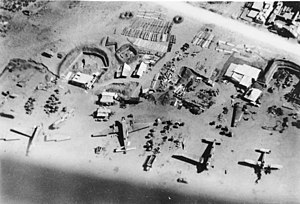 Aircraft being repaired in Maleme, August 1941 | |
| Location | |
| Objective | Commando raids on German airfields in the Axis-occupied Greek island of Crete |
| Date | 7/8 June 1942 4/5 July 1943 |
| Executed by | |
| Outcome | Allied victory |
| Casualties | 12 German soldiers Pierre Léostic † 3 Free French captured 62+ citizens killed |
Operation Albumen was the name given to British Commando raids in June 1942 on German airfields in the Axis-occupied Greek island of Crete, to prevent them from being used in support of the Axis forces in the Western Desert Campaign in the Second World War. The operations were carried out with similar raids against Axis airfields at Benghazi, Derna and Barce in Libya and were among the first planned sabotage acts in occupied Europe.
Overview
[edit]During the late spring of 1942, the airfields of Crete gained increased importance by becoming the main transit base for the Luftwaffe to fly supplies to the Axis forces in Egypt in their advance on the Nile Delta. Luftwaffe aircraft based on Crete operated photo-reconnaissance, bombing and convoy attack missions covering the south-east Mediterranean. To disrupt these operations, British generals in Cairo sent three groups from the Special Boat Squadron (SBS) and one from the Special Air Service (SAS) to Crete to sabotage the airfields of Heraklion, Kastelli, Tympaki and Maleme.[1]
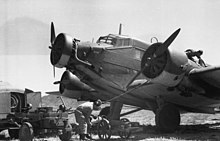
Aircraft types operating from Crete at the time included the Ju 52 and Me 323 for transport, the Ju 88 and Ju 86 for bombing and photo-reconnaissance and the Bf 109 as a fighter.
Heraklion airfield was allocated to the SAS group and the SBS groups were assigned to the other three airfields. The SBS groups were met by Tom Dunbabin, the British liaison officer with the Cretan resistance, who provided them with local guides. The sabotage attacks were scheduled for the night of 7/8 June 1942
The Raids
[edit]Kastelli operation
[edit]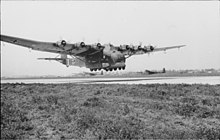
The attackers on Kastelli consisted of Captain G. I. A. Duncan of the Black Watch, two NCOs of the SBS and the Greek gendarme Vassilis Dramoundanis. The operation unfolded according to plan and on 7 June the saboteurs, assisted by the locals Giorgos Psarakis, Kimonas Zografakis (nicknamed Blackman) and Kostas Mavrantonakis, managed to destroy 5 aircraft, damage 29 others and set fire to several vehicles and considerable quantities of supplies (including about 200 long tons (200 t) of aviation fuel) using delayed-action bombs.[2]
The June 1942 operation is often referred to as the first raid on Kastelli, because of a similar operation that took place a year later. One of the objectives of this second operation was to lead the Germans into believing that an Allied landing on Crete (rather than their true intentions, the Allied invasion of Sicily) was imminent. On the night of 4/5 July 1943, two commando groups under the Danish Major Anders Lassen and the Greek Kimonas Zografakis, simultaneously attacked the airfield of Kastelli from two directions. Despite the strong security, they succeeded in deceiving the garrison and destroyed most of the parked aircraft and fuel dumps.[3][4]
Heraklion operation
[edit]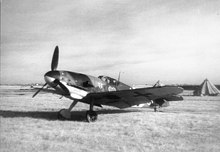
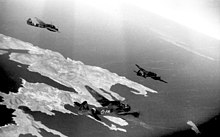
The Heraklion operation was commanded by George Jellicoe and included four members of the Free French Forces commanded by Georges Bergé (the other three being Jacques Mouhot, Pierre Léostic and Jack Sibard) and Lieutenant Kostis Petrakis of the Hellenic Army. The group was transferred to Crete on board the Greek submarine HS Triton (Y-5) and rowed ashore in three inflatable boats. They had intended to land at Karteros beach but came ashore in the Gulf of Malia on the dawn of 10 June and late.[5] The men had to march overland to reach Heraklion airfield. They hid by day, and marched throughout the nights, finally arriving during the night of 12/13 June. Due to increased traffic caused by a succession of night sorties that was in progress, the team had to postpone their attack until the next evening. The group entered the airfield while it was being bombed by the Royal Air Force (RAF) and destroyed about 20 Ju 88s using Lewes bombs. All six saboteurs escaped from the airfield but their retreat was betrayed, resulting in 17-year-old Pierre Léostic being killed and the other three Frenchmen being arrested. Jellicoe and Petrakis escaped to Egypt.[6][7]
Tympaki operation
[edit]The Tympaki team (led by David Sutherland of the Black Watch) discovered that due to air raids from Egypt, the airfield had been temporarily abandoned and the aircraft based there had been moved.
Maleme operation
[edit]The Maleme team was made up of Captains Michael Kealy and James Allott who landed on Crete aboard the Greek submarine Papanikolis. After a difficult march, they reached Maleme but were also unsuccessful. They discovered that the airfield was strongly guarded and was recently equipped with electrified fences, making it impossible to penetrate its perimeter.
Aftermath
[edit]As a result of the raids, 25 aircraft were completely destroyed, many more damaged and 12 German soldiers killed. In reprisal for the sabotage in Heraklion, the occupation forces executed fifty inhabitants of the greater Heraklion area the next day. Prior to the attacks, on 3 June, the Germans had executed another twelve Heraklion citizens. The Avenue of the 62 Martyrs (Greek: Λεωφόρος 62 Μαρτύρων) in modern Heraklion is named in remembrance of the victims.
On 23 June, Jellicoe, Petrakis and the participants of the Kastelli and Tympaki operations were evacuated to Mersa Matruh, Egypt on a caique from Trypiti beach near the village of Krotos in south Crete. They reached Mersa Matruh shortly before it fell to Rommel's advancing forces. Jellicoe was later awarded the Distinguished Service Order. After several days of interrogations under the threat of execution, Bergé, Mouhot and Sibard, who were captured after the Heraklion sabotage, were transferred to the Oflag X-C war prisoner camp in Germany. Eventually, Bergé ended up in Colditz castle in Saxony where prisoners who had repeatedly attempted to escape were held. There, Bergé joined SAS commander David Stirling who had been captured in the meantime. To honour the memory of Pierre Léostic, Kostis Petrakis christened his son after him.
The failure to prevent the raids on the airfields was one of the reasons that led to the replacement of General Alexander Andrae by Bruno Bräuer as commander of Crete.
See also
[edit]References
[edit]- ^ Beevor, Antony (1992). Crete: The Battle and the Resistance. London: Penguin. ISBN 978-0-14-016787-0.
- ^ "Ο Γερμανός επιλοχίας θυμάται: Ο Γερμανός επιλοχίας θυμάται". Retrieved 20 January 2017.
- ^ "Β' σαμποτάζ Αεροδρομίου Καστελίου: 4-5 Ιουλίου 1943: Β' σαμποτάζ Αεροδρομίου Καστελίου: 4-5 Ιουλίου 1943". Retrieved 20 January 2017.
- ^ Thompson, Leroy. SAS: Great Britain's Elite Special Air Service, Zenith Press, ISBN 978-0-87938-940-6, 1994.
- ^ "Η άγνωστη ιστορία του σαμποτάζ στο αεροδρόμιο: Το Σαμποτάζ στο αεροδρόμιο Ηρακλείου (13/14 Ιουνίου 1942)". Retrieved 20 January 2017.
- ^ Sibard, Jack L. (2006). Mission En Crete. Société des Etudes Historiques Crétoises. ISBN 978-960-87170-5-3.
- ^ Σανουδάκης, Αντώνης (1989). Ιππότες του ονείρου. Αφήγηση Κωστή Πετράκη. εκδόσεις Κνωσός. ISBN 978-960-207-009-3.
Further reading
[edit]- Gartzonikas, Panagiotis (2003). Amphibious and Special Operations in the Aegean Sea 1943–1945. Operational Effectiveness and Strategic Implications (MA thesis). Monterey, CA: Naval Postgraduate School. pp. 46–47. OCLC 834259345. Retrieved 19 December 2017.[dead link]
- Roskill, S. W. (1962) [1956]. The Period of Balance. History of the Second World War: The War at Sea 1939–1945. Vol. II (3rd impression ed.). London: HMSO. OCLC 174453986. Retrieved 19 December 2017.
- Woodman, R. (2003). Malta Convoys 1940–1943 (pbk. ed.). London: John Murray. ISBN 978-0-7195-6408-6.
External links
[edit]- Earl Jellicoe interviewed, also describes Heraklion operation
- Heraklion operation from France Libre (in French -- translate)
- Obituary: General Georges Berge
- Sabotage /62: Historical Museum of Crete (in Greek -- translate)
- Conflicts in 1942
- Attacks on buildings and structures in Greece
- Crete in World War II
- Battles and operations involving the Greek Resistance
- Mediterranean theatre of World War II
- Special Air Service operations
- 1942 in Greece
- World War II British Commando raids
- World War II sabotage
- Military operations involving airports
- Attacks on military installations in 1942
- Attacks on air bases
- Airport bombings in Europe
